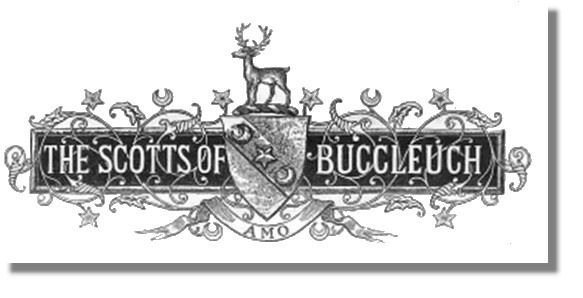
Scottish Castles Photo Library
- Buccleuch Castle, Scottish Borders


It is thought that the Scotts moved into Galloway in the south west of the country towards the end of the 10th century but the real cradle of the Scotts, however, was at Scotstoun and Kirkurd in the county of Peebles. There is clear evidence that the Holy Cross Kirk at Peebles was the burial place of the Scott chiefs for many generations. Even as late as 1492, David Scott of Buccleuch, who died at Rankilburn, left instructions in his will that his body should be buried in this Peebles church even though the Scotts had long ceased to live at Scotstoun. (Graphic of Holy Cross Church, Peebles © Kevin Rae via Wikimedia Commons).
It was in the early 1100's when Uchtred Filius Scoti, was recorded as the first member of the Scotts, signing as a witness to David 1's charter to Holyrood Abbey in 1128 and 1130. Uchtred had a son - Richard Scott, who witnessed a charter by the Bishop of St Andrews to the Abbey of Holyroodhouse about the year 1158. Richard had two surviving sons, one of whom was another Richard, who married Alicia, daughter and heiress of Murthockston of that Ilk (signifying that he was a landowner). Richard succeeded to these lands in Roxburghshire in the reign of Alexander II, becoming Sir Richard Scott, Lord of Rankilburn and Murthockston. A castle was probably built by that Robert Scott after he had received grants of land at Rankilburn and Buccleuch when he was made ranger of Ettrick Forest. Richard swore loyalty to Edward I of England in 1296 (in the infamous Ragman Rolls") under the name ‘Richard Le Scot de Murthoxtoun’. He may have been the first Scott to have local lands at Rankilburn, sometime before 1296. Richard died around 1320.
Richard's descendants later used the Buccleuch name rather than Rankilburn. The graphic is of Rankil Burn in the autumn. Afterwards, the "Scott Country" lay between the rivers Teviot and Yarrow and they had the greater part of Upper Teviotdale with several possessions on the Yarrow and a footing in Eskdalemuir and on the forfeiture of Francis Stuart, Earl of Bothwell, they came into possession of wide domains in Liddesdale.As befitted their increasing status, the Scott family built a castle or manor house on ground at the junction of the Rankil and Buccleuch Burn.
In those days castles were built with thick stone walls but no illustration of what the castle looked like in those days has survived - in all probability the building would have been attacked and destroyed more than once over the centuries. In 1494 it is known to have suffered considerable damage from a raid by Simon Routledge and accomplices, who, after removing the cattle, horses and sheep, plundered the building and set it on fire. In the judicial proceedings against the invaders, it is called "the place and manor of Bukcleuch" and was occupied by the "Knight of Buccleuch" (consistent spelling of place names was not a feature of records in those days). It continued to be one of the main residences of the family for many years afterwards. But their removal from Murthockston to Branxholm gradually superseded the mansion of Buccleuch as the principal Border residence of the family.
The foundation walls of a castle were discovered when the farm-house of East Buccleuch was built in 1832, using stones from the old ruined castle in its construction. The farmhouse has the date 1832 carved above the entrance, and above it the crescent moon of the Scotts of Buccleuch which harks back to the days when the Scotts were involved in "reiving" (cattle rustling) by the light of the moon. It is said that under the farm is a dungeon and escape tunnel. Noises from West Buccleuch House on the other side of the Rnkil Burn can sometimes be heard in the farm.
Today, there are two buildings in this area - East Buccleuch farmhouse stands on the site of the earlier castle/manor house while across the Rankil Burn is "West Buccleuch House". This latter building was up for sale in late 2015 ("offers around £700,000) and according to the prospectus at one time in the past it was a hotel and still boasts an indoor swimming pool. No doubt Sir Richard Scott, Lord of Rankilburn and Murthockston would have enjoyed those facilities!
Return to the Castles Photo Library Index
or go to the next castle:  Buchanan Castle.
Buchanan Castle.
Where else would you like to go in Scotland?
Where else would you like to go in Scotland?

